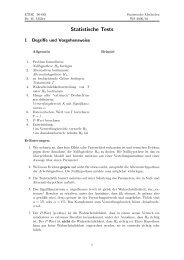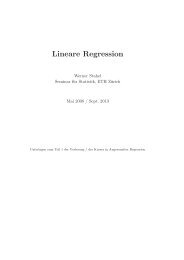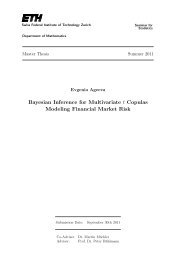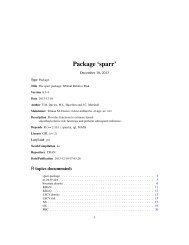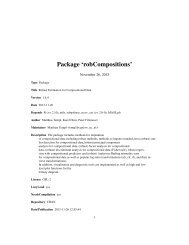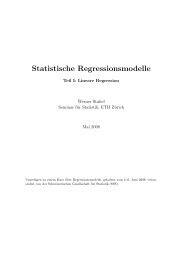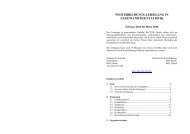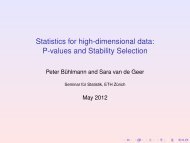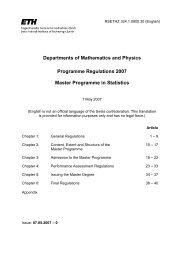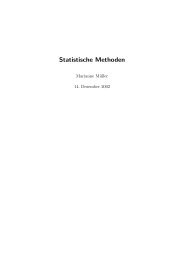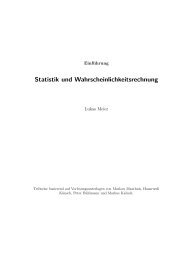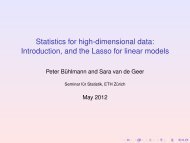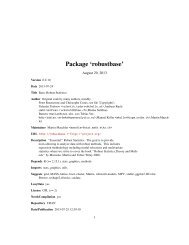Package 'rgenoud'
Package 'rgenoud'
Package 'rgenoud'
You also want an ePaper? Increase the reach of your titles
YUMPU automatically turns print PDFs into web optimized ePapers that Google loves.
4 genoud<br />
Domains<br />
This is a nvars ×2 matrix. For each variable, in the first column is the lower<br />
bound and in the second column the upper bound. None of genoud’s starting<br />
population will be generated outside of the bounds. But some of the operators<br />
may generate children which will be outside of the bounds unless the<br />
boundary.enforcement flag is turned on.<br />
If the user does not provide any values for Domains, genoud will setup default<br />
domains using default.domains.<br />
For linear and nonlinear constraints please see the discussion in the Note section.<br />
default.domains<br />
If the user does not want to provide a Domains matrix, domains may nevertheless<br />
be set by the user with this easy to use scalar option. Genoud will create a<br />
Domains matrix by setting the lower bound for all of the parameters equal to -1<br />
× default.domains and the upper bound equal to default.domains.<br />
solution.tolerance<br />
This is the tolerance level used by genoud. Numbers within solution.tolerance<br />
are considered to be equal. This is particularly important when it comes to evaluating<br />
wait.generations and conducting the gradient.check.<br />
gr<br />
A function to provide the gradient for the BFGS optimizer. If it is NULL, numerical<br />
gradients will be used instead.<br />
boundary.enforcement<br />
This variable determines the degree to which genoud obeys the boundary constraints.<br />
Notwithstanding the value of the variable, none of genoud’s starting<br />
population values will be outside of the bounds.<br />
lexical<br />
boundary.enforcement has three possible values: 0 (anything goes), 1 (partial),<br />
and 2 (no trespassing):<br />
• 0: Anything Goes This option allows any of the operators to create out-ofbounds<br />
individuals and these individuals will be included in the population<br />
if their fit values are good enough. The boundaries are only important when<br />
generating random individuals.<br />
• 1: partial enforcement This allows operators (particularly those operators<br />
which use the derivative based optimizer, BFGS) to go out-of-bounds during<br />
the creation of an individual (i.e., out-of-bounds values will often be<br />
evaluated). But when the operator has decided on an individual, it must be<br />
in bounds to be acceptable.<br />
• 2: No Trespassing No out-of-bounds evaluations will ever be requested. In<br />
this case, boundary enforcement is also applied to the BFGS algorithm,<br />
which prevents candidates from straying beyond the bounds defined by<br />
Domains. Note that this forces the use of the L-BFGS-B algorithm for<br />
optim. This algorithm requires that all fit values and gradients be defined<br />
and finite for all function evaluations. If this causes an error, it is suggested<br />
that the BFGS algorithm be used instead by setting boundary.enforcement=1.<br />
This option enables lexical optimization. This is where there are multiple fit<br />
criteria and the parameters are chosen so as to maximize fitness values in lexical




